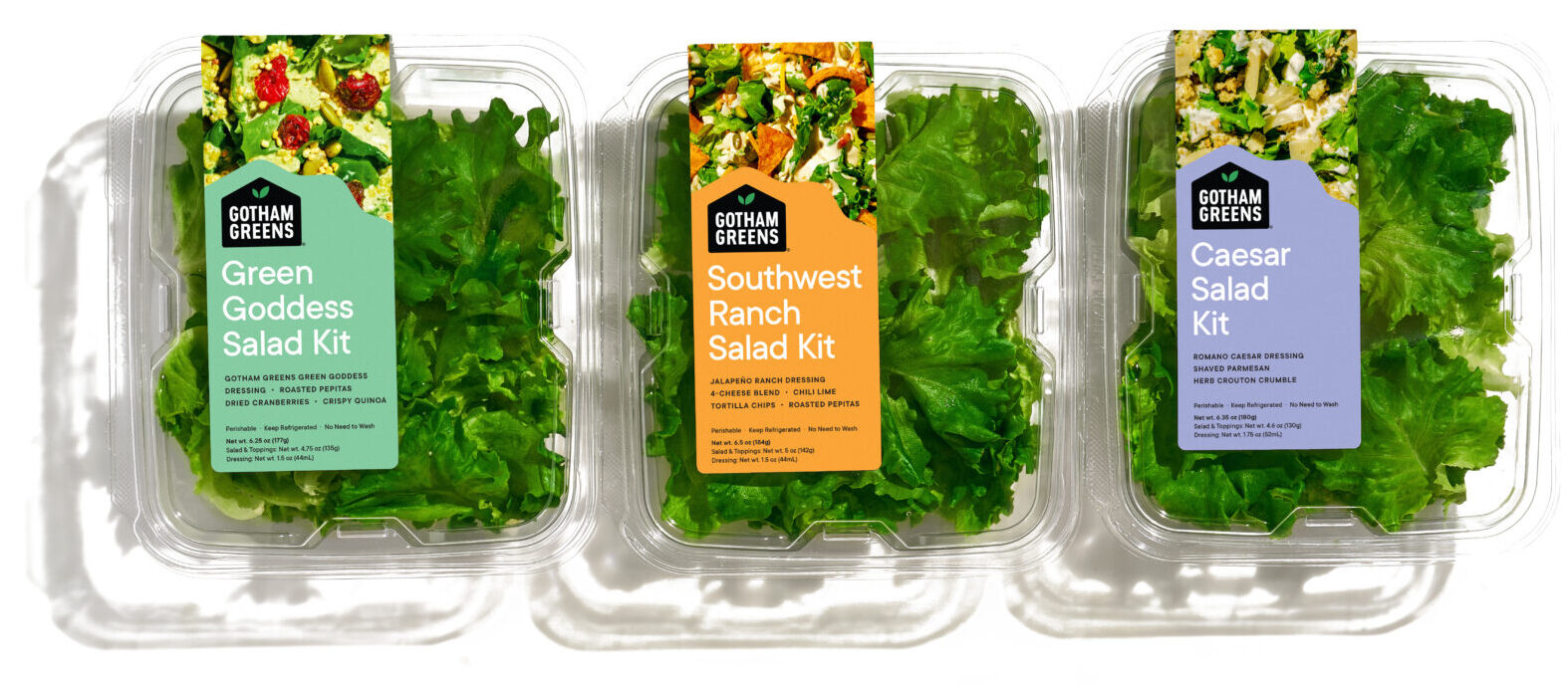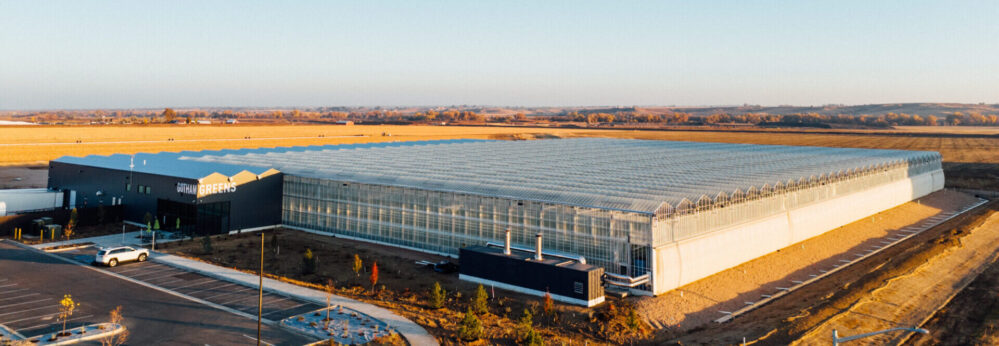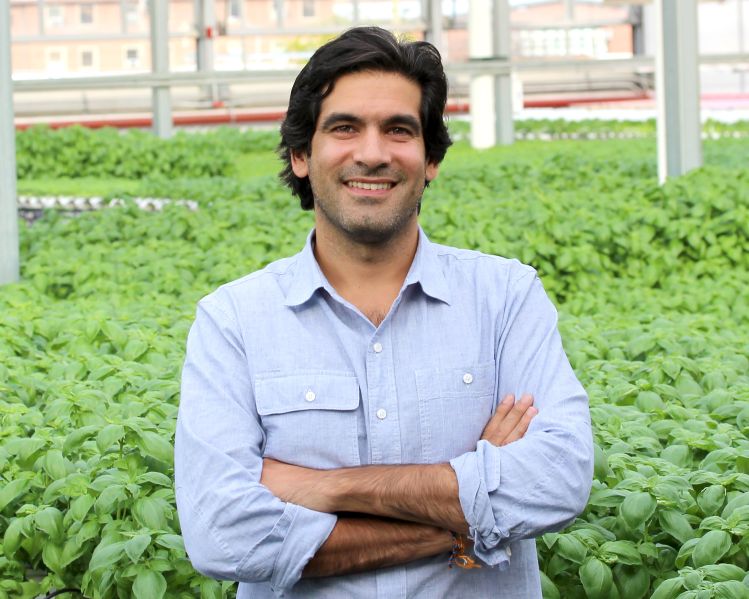Amid the recent flood of bankruptcies, layoffs, and grim headlines, the casual observer might be forgiven for thinking that the entire indoor farming segment is on the verge of implosion. The reality, says the cofounder of New York based Gotham Greens, is very different.
“The future, I believe, is very bright for the sector,” says Viraj Puri, who helped introduce many Americans to the concept of hydroponic farming after opening a first of its kind rooftop greenhouse in Greenpoint, Brooklyn in 2011 and has since built a network of 13 climate-controlled facilities across nine states.
“But like any industry that’s going through a nascent stage, there are going to be bumps in the road,” he observes. “There are going to be some business models and companies that succeed and some that unfortunately don’t, so I think we’ll see some consolidation. But overall, this is an industry that’s proven with a clear value proposition.”
Gotham Greens—which operates high-tech ‘horizontal’ greenhouses primarily utilizing sunlight (as opposed to multi-storied vertical farms using artificial lighting)—has raised a cool $440 million since 2009 but has demonstrated it can deploy its investors’ capital efficiently and make money, claims Puri.
“From the beginning our focus has been on unit economics and trying to make sure each greenhouse is as profitable and efficient as it can be. We’re very ambitious but have always balanced that with conservatism, focusing on crops that we know can be profitably grown.”
AgFunderNews (AFN) caught up with Puri (VJ) to discuss funding indoor ag, why technology is a tool, not an end in itself, and why plants are not widgets that come down an assembly line.
AFN: How did you get interested in indoor farming?
VJ: I don’t come from a food background, but I was exposed to a hydroponic greenhouse while working as a project manager and just became fascinated by the concept; it is such a resource-efficient way to grow food, using less land and water and fewer chemical inputs.
By growing in a controlled environment, you don’t have to face adverse weather conditions and you can have more consistent and reliable production all year round. Given the climate control and the hydroponic irrigation, the growing time for these crops is also much faster, plus you can grow a lot more product in a smaller footprint vs open field agriculture.
My first key takeaway from researching the market was just how robust the technology was and how widely deployed it already was, particularly in the Netherlands, Canada and Mexico.
But the majority of the commercial deployment was on flowers or vine crops such as tomatoes, cucumbers and peppers, so my second key takeaway was why not grow lettuce this way? Leafy greens is a larger commodity class than all three of those other edible commodities combined, yet virtually no lettuces were being grown hydroponically in greenhouses [when Puri and cofounder Eric Haley first started researching the market in the early 2000s].
The other thing that struck me was that in the United States and Canada, the majority of leafy greens that are sold in foodservice and retail are grown in two major growing regions: California and Arizona. And so we have a large addressable market but highly concentrated production. So the thesis was, why not take this commercially-proven, ecologically robust greenhouse hydroponic technology, and build it in close proximity to New York City and the surrounding area, which serves 25 million people?
AFN: How did you meet your cofounder Eric Haley?
VJ: I met Eric during our college days in Europe in a study abroad program, but one early light bulb moment came for us in the early 2000s when we were kicking around a business plan for Gotham Greens over dinner at a restaurant in Brooklyn. We were doing a lot of market research, looking at menus, talking to chefs and people involved in the produce supply chain, and constantly asking people where their produce was coming from.
At this one particular restaurant, we asked the waiter where the basil came from and he had no clue. He asked the manager and the chef and came back later and said it was grown in Israel and flown to New York. We figured there had to be a better way.
Our third key partner is Jenn Frymark, our chief greenhouse officer, and a very well renowned plant scientist. So really, the three of us have built this business together over the last 15 years.
AFN: What model of indoor farming did you pick and why?
VJ: We only really considered greenhouses; we didn’t consider vertical farming. We liked greenhouses because they were already proven. Our underlying thesis was to deploy this widely deployed technology in the United States but with leafy greens, and closer to cities. It wasn’t particularly about being a technology developer; it was more about being a highly efficient farm operator.
AFN: Tell us about your first greenhouse
VJ: It was pretty small, a 15,000sq ft greenhouse on a warehouse rooftop in Brooklyn that was really intended to be a proof of concept. We didn’t have any big investors; it was funded through small business loans, grants and some friends and family capital. It was a small scale science project of sorts. But we had immediate commercial success; there was such strong demand from local supermarkets and restaurants who were responding to the quality of the product, how consistent it was, how much longer it was lasting, and how it was noticeably fresher.
Our first farm was profitable within a few months of opening, so we realized we might be onto something big.
We then parlayed that into our second greenhouse, which was built on top of a Whole Foods Market in Brooklyn, this time around 20,000sq ft, and I really believe that it served as an inspiration for much of the more contemporary urban and hydroponic farming movement. Many people in the US hadn’t heard of it at the time, but when one of the nation’s most influential grocery chains has such a high profile project, it generates a lot of media attention and exposure.
AFN: How did your greenhouses evolve after that?
VJ: It was really after that, that we decided to raise institutional capital and embark on a much more ambitious journey to build a real company. But the fundamentals haven’t changed since those early rooftop greenhouses; we still rely primarily on natural sunlight [supplemented with some LEDs] and we use hydroponic recirculating irrigation systems to grow lettuce in a controlled environment.
What’s changed is the greenhouses have gotten much larger and more automated, in part because the technology has really evolved. The OEMs [original equipment manufacturers] have done a lot of work to progress the growing systems and technologies, so there’s been a longer menu of options to choose from which has allowed us to increase productivity and efficiency, reduce labor, and improve crop yields.
There have also been advancements in climate control technologies to allow the greenhouses to have a much more uniform and dynamic climate environment to respond to the plants’ needs.
AFN: Can your model work anywhere?
VJ: We believe our model works anywhere in the United States, but in certain markets, the electricity usage is higher in certain months or the electric rates are higher due to the energy markets in that state.
Energy is a cost that we can manage quite well in our greenhouses. It’s not one of our primary costs. We believe greenhouse farming that relies on natural sunlight is probably the most efficient, least energy intensive form of indoor farming.
We keep iterating but the last three greenhouses [in Colorado, Georgia, and Texas] are substantially similar in design and in size. So we do feel that we have created a profitable, scalable template that can be rolled out to multiple geographies, with the understanding that we’re going to make tweaks along the line based on new technologies, new learnings, and the nuances of certain geographies.
AFN: What kind of tech do you deploy in your farms?
VJ: There are robotic arms that perform certain tasks and there are a lot of conveyors that move the plants across the greenhouse over the course of their life. There are also some automated harvesting and packaging systems, but it’s not super-fancy never-been-tested technology, more off the shelf technology that has been applied in other industrial settings, just with some additional tweaks.

AFN: Why do you think so many high-profile vertical farms have struggled in recent years?
VJ: I can’t speak for them. My guess is that the promise of exponentially higher yields in a smaller footprint was very compelling, but there are also challenges around technology, the lighting, the energy costs, how the plants interact being on so many different layers.
But I don’t want to make sweeping statements about certain models. Growing plants is not easy anywhere, and if there’s any misconception about what we do it’s to think that growing in an indoor environment is somehow easier [than open field farming]. There’s a lot of complexity. It truly is a combination of advanced horticultural and engineering techniques.
Intuitively one would think that one is protected from the elements with a lot of sensors and computer control systems and software, that one just has to push a button and tomatoes or heads of lettuce will come out on the other end, but nothing can be further from the truth.
At the end of the day, we are dealing with a living, biological product. There can be pests, disease, safety issues, human error, and plants are not always going to react in predictable ways.
It’s also highly capital intensive and highly operationally intensive and you’re dealing with a highly perishable product. So I don’t necessarily think that the companies who have had struggled have been bad operators with bad management teams or bad investors; this is just a very challenging industry to scale.
It requires a combination of factors, real estate development, financing, great growing operations, and dealing with the processing and distribution of highly perishable food products.
AFN: Are there fewer food safety issues with greens grown indoors in water?
VJ: There is a potentially reduced risk from operating in a controlled environment, but contamination can still happen. It can be as simple as someone not washing their hands. However, structurally, an indoor farm that uses potable drinking water for irrigation is less susceptible to certain types of food safety risks compared to an open field farm that may get cross contaminated with livestock manure or something like that.
AFN: How have you financed your business?
VJ: The picture has become much clearer for us on what the farms will cost, what the return on investment is, what the IRR [internal rate of return] profile is, and that’s a function of us being in business for 13 years and building different types of greenhouses in varying scales in various regions of the country.
So we believe we now have refined and calibrated the financing structure that works for this business.
Our early investors were friends and family and angel investors, small business loans and some grants. Then we progressed to smaller scale VC investors, and to more growth equity investors, and then to much larger infrastructure-type investors for project finance. Cumulatively, including both equity and debt financing, we’ve raised about $440 million.
I think in terms of the amount of greenhouse space that we’ve built and the revenue we’ve generated relative to capital invested, I think we’ve probably done reasonably better than some of our peers. But that’s not to say that other peers haven’t been even more efficient.
Indoor farming is not like a SaaS [software as a service] business that might have exponential growth and it’s possible that some of the investors who backed some of the companies with large checks and large valuations perhaps had that in mind, but I can’t comment on that with any authority.
The overall market backdrop has clearly become more difficult for venture and early stage companies given the rise in the cost of capital. And then in some cases we saw some young and inexperienced businesses finding themselves with a lot of money and some approached the public markets with not enough experience.
AFN: What’s your business model? Do you own and operate your own facilities?
VJ: Yes, we own the greenhouses and the real estate for the most part and that’s a model that currently works for us. But we’ve seen other models where asset managers own the assets and then lease them to the farming operators, so that’s an interesting model as well.
AFN: What’s the exit strategy for your investors?
VJ: Right now our company is in growth mode. We are focused on scaling the new greenhouses, increasing utilization of those greenhouses, and improving our margins while continuing to grow and build new greenhouses.
But we are confident that we will deliver some sort of a liquidity event to our principal shareholders in the coming years. I don’t know what that looks like, exactly, but I think there can be a variety of exit scenarios. I think this could be a very successful public company; we’ve seen other successful public companies in the indoor sector. It’s a capital-intensive business, which I think lends itself well to the public markets where you can access cheaper forms of capital.
I see it as being potentially really interesting for infrastructure and asset investors but also to farmland investors and other types of asset investors who have a longer term outlook and like the predictability and long term outlook of farming.
In addition, Gotham Greens and many of our competitors are building brands that are resonating with consumers and commanding brand loyalty, so I could see a lot of consumer investors being interested in this space for potential acquisition, as well. But that being said, we’re not seeking an exit right now.

AFN: What crops does it make sense to grow hydroponically?
VJ: Technically, hydroponics is just a nutrient delivery system, so one can grow anything hydroponically, but the crops that tend to be commercially viable are tomatoes, cucumbers, peppers, leafy greens, herbs, and strawberries. But our focus is on leafy greens for the foreseeable future because we see such a large market opportunity.
AFN: What is your next move? Do you have international expansion plans?
VJ: Our current focus is in the US and we’re currently exploring new sites.
AFN: Does more work need to be done on breeding seed varieties specifically for indoor farming operations?
VJ: Yes, that is certainly happening. Many of the seed breeding companies and genetics companies are increasingly doing research and development for seed varieties that are especially suited to be grown indoors, so I think that will be a great advancement for our industry.
AFN: How is Gotham Greens performing?
VJ: I would say quite successfully. Our focus from day one has been on unit economics and trying to make sure each greenhouse is as profitable and efficient as it can be. And I think we’ve been good stewards of our investors’ capital.
I’m a huge proponent of indoor farming and I believe there is an enormous market opportunity, while at the same time the challenges facing open field farming are only going to grow, whether it’s climate risk and extreme weather, drought, or labor issues.





